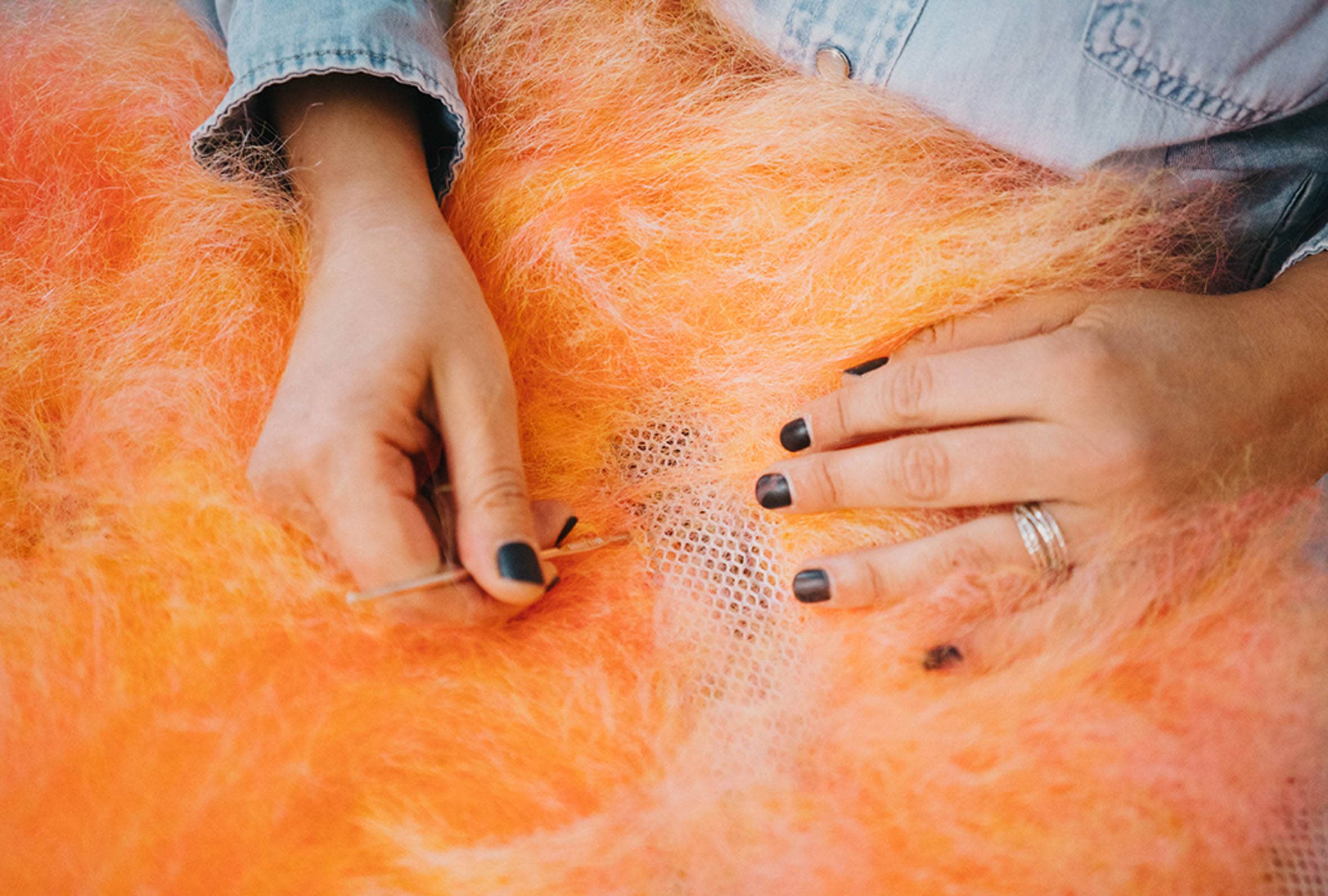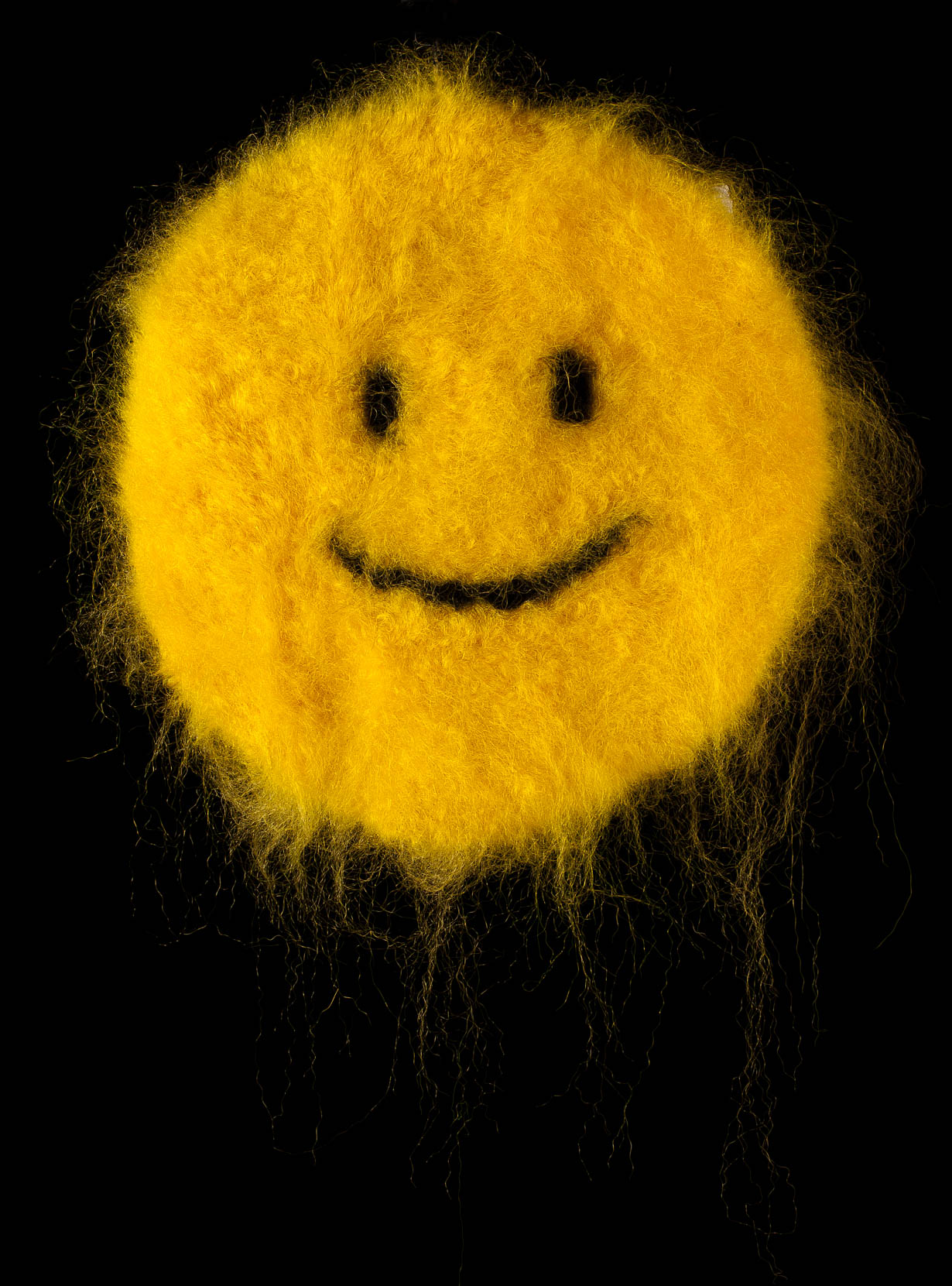ART + CULTURE: We meet Icelandic artist Shoplifter at her hair-filled Brooklyn studio
Images: Shoplifter, Inez van Lamsweerde + Vinoodh Matadin, Panos Damaskinidis
Video: Antonio Celotto
Interview: Emma de Clercq
The Brooklyn studio of Icelandic artist Hrafnhildur Arnardóttir, a.k.a Shoplifter, is a chaotic treasure trove. Boxes crammed full of bright materials are stacked floor to ceiling, sculptures and drawings cover every surface. It’s a fitting introduction into the magical world of Shoplifter, a place where colour reigns.
Drawing from varied sources of inspiration (supernovas, human behavioural patterns and black holes, to name just a few) Shoplifter’s practice defies summarisation – which is just how she likes it. “I don’t see the need for art, fashion, design and craft to be separated completely – I like that there can be grey areas” she says. She primarily creates sculptures, installations and performances, and often collaborates on fashion and design projects. These include working with Björk on the creation of her Medúlla album cover, designing custom wallpaper for Nike, and teaming up with various designers to create one-off fashion garments.
Hair is a recurring feature in Shoplifter’s work. Drawn to the fibre for its visual and stylistic possibilities as much as its symbolic associations, she works with both human and artificial hair, favouring synthetic hair extensions in vibrant rainbow colours. On what draws her to this material, she explains, “it’s trashy looking, more associated with Halloween, wigs and dressing up. Using it was my way of bringing down my own preconceptions about what is ‘noble’ and what’s not, to use something that is really low quality but make it look like something glorious”.
"Hair is a remnant of the wildness that we possess"
Born in Iceland, Shoplifter has been based in New York for twenty years. She explains, “when I was trying to figure out where to go for my MA, every time I thought about myself in Europe I saw it in black and white, and every time I saw myself in New York I saw it in colour. I thought… I’m going with the colour!” Indeed, colour plays a defining role in Shoplifter’s work. Rather than shy away from it as many contemporary artists do, she embraces it. In fact, it has become something of a signature. “One of the first pieces I ever did was in the window of MoMa. It was very baroque, maximalist and kind of loud.” she recalls, “I’m still meeting people who tell me how happy it made them to pass by this window filled with all this colour – almost like colour therapy”.
In her work, hair is manipulated in every way. It is brushed, woven, plaited and even melted. Sometimes it is braided into giant murals, or moulded into odd, charming figures, whose tongue-in-cheek titles (such as Bearded Loner About To Bend Over) reiterate her playful nature. Humour is at the core of her practice. After all, she argues, one of the most powerful things about art is surely its ability “to make people happy”?
We sat down with Shoplifter at her Brooklyn studio to discuss all things hair and art.
Where did the name Shoplifter originate from? My real name, Hrafnhildur, is an Icelandic name, it means battle between ravens. When I first moved to New York, I was introduced to someone and when I said ‘hi, my name is Hrafnhildur’, she answered ‘nice to meet you… shoplifter?’ She was totally horrified trying to repeat what I’d just said. I just started laughing, I thought, this is going to be hopeless. In the end people just remembered shoplifter because it’s so funny. I have a very colourful personality and I’m very humorous, I take myself seriously but I really don’t want to take myself ceremoniously. I think that by using my nickname Shoplifter I pretty much took care of that. You can’t really take yourself seriously when you use that name!
What draws you to hair as a medium? I find it fascinating that we have this forever changing ‘vegetation’ all over our bodies, which we have to groom and tame. Hair is a remnant of the wildness that we possess, and one of the few things that survives our existence. It’s like a shield, or alternatively it can be a way of showing yourself to the world. A lot of people find hair so creepy once it’s off the body, yet it’s such a pride and beauty when it’s on the body… even though it’s the same fibre. When I work with hair I hope to evoke these simultaneous feelings, the opposites of disgust and beauty. In many ways hair pulls you in because of its ornamental elements, its colours and softness… it’s almost cuddly. But at the same time you can feel disgusted because of its volume, and you have to decide in the moment – which way are you going to go? It pulls you in two directions and then you have to settle onto one feeling. There’s such a fine line between the grotesque and the beautiful.
What currently inspires you? I am inspired by humans. Behavioural patterns, group mentality, group identity… I also like to read about the latest developments in neuroscience and brain research. I remember when I had just finished making an installation called Nervescape out of hair, and then I came across images of neurones in the brain. It looked so similar to my work, I couldn’t believe it!
Has your use of hair changes over the years? I consider a thread of hair to be like a line on paper. In the beginning I used brown hair because I wanted to comment on the humanity of it, and I thought it would be more expensive and fancy. Later I started using very artificial looking, colourful synthetic hair extensions. I like that it’s trashy, more associated with Halloween, wigs and dressing up. It was my way of bringing down my own preconceptions about what is ‘noble’ and what’s not, to use something that’s really low quality but make it look like something glorious. I also like to use it in huge quantities, showing a volume of hair that you’re not used to. We’re used to only having a certain amount of hair on one person, so it’s interesting to see a lot of it all together.
You’ve collaborated on projects across different disciplines, such as the Medúlla album cover with Björk. Can you tell us about these collaborations? I had an exhibition at ATM Gallery in New York, Björk saw it and asked me to help develop her look for her album. It was recorded using only human voices, no instruments, so she wanted to have something which was closely related to the body. We did basket weave hair pieces and braids. For me, I saw it like making a still-life composition, a wearable sculpture. I like flirting with fashion and pop culture, I’m not very supportive of the snobbery of ‘high art versus low art’. I don’t see the need for art, fashion, design and craft to be separated completely – I like that there can be grey areas. More and more people are working in these grey areas. I really want to allow myself to explore different ways of making things. For example, I have a great passion for dressing up and costume, so when I get a chance to design clothing, I welcome it! When it comes to floating between disciplines I’m a bit of a flirt.
- ANTHROPOLOGY OF HAIR
- ANTHROPOLOGY OF HAIR
- ANTHROPOLOGY OF HAIR
- ANTHROPOLOGY OF HAIR
- ANTHROPOLOGY OF HAIR






















